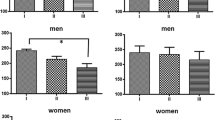Abstract
Preclinical and clinical studies have suggested that the acoustic startle reflex (ASR) is a useful model to investigate the neurochemical basis of anxiety and fear states. This work has revealed that the anxiogenic alpha-2 receptor antagonist, yohimbine, increases the amplitude of the ASR in laboratory animals and in healthy human controls. Because of the growing body of data that support the hypothesis that severe stress results in substantial alterations in noradrenergic neuronal reactivity, the present investigation evaluated the effects of yohimbine on the ASR of 18 patients with PTSD and 11 healthy combat controls. Subjects received IV yohimbine (0.4 mg/kg) or saline placebo on 2 separate days in a randomized double blind placebo control design. A trial of two tone frequencies with varied intensity (90, 96, 102, 108, 114 dB) white noise and instantaneous rise time, was delivered binaurally through headphones. Tones were delivered every 25–60 s, for a 40-ms duration. Startle testing was performed 80 min post-infusion and lasted 15–20 min. Yohimbine significantly increased the amplitude, magnitude and probability of the ASR in combat veterans with PTSD, but did not do so in combat controls. Overall startle was significantly larger in the PTSD subjects; however, this did not account for the differential effect of yohimbine, since yohimbine had no significant effect in the control group. This study demonstrates an excitatory effect of yohimbine on the amplitude, magnitude and probability of the ASR in PTSD patients that is not seen in combat controls. In the context of the key role of this reflex in the alarm response, this finding adds to the array of documented behavioral, biochemical and cardiovascular effects of yohimbine in humans which support the relationship between increased noradrenergic function and exaggerated startle symptomatology of PTSD.
Similar content being viewed by others
References
Brown JS, Kalish HI, Farber IE (1951) Conditioned fear as revealed by magnitude of startle response to auditory stimulus. J Exp Psychol 41:317–327
Butler RW, Braff DL, Rausch JL, Jenkins MA, Sprock J, Geyer MA (1990) Physiological evidence of exaggerated startle response in a subgroup of Vietnam veterans with combat related PTSD. Am J Psychiatry 147:1308–1312
Charney DS, Heninger GR, Breier A (1984) Noradrenergic function in panic anxiety: effects of yohimbine in healthy subjects and patients with agoraphobia and panic disorder. Arch Gen Psychiatry 41:751–763
Charney DS, Woods SW, Goodman WK, Heninger GR (1987) Neurobiological mechanisms of panic anxiety: biochemical and behavioral correlates of yohimbine-induced panic attacks. Am J Psychiatry 1447:1030–1036
Charney DS, Woods SW, Krystal JH, Nagy LM, Heninger GR (1992) Noradrenergic neuronal dysregulation in panic disorder: the effects of intravenous yohimbine and clonidine in panic disorder patients. Acta Psychiatr Scand 86:273–282
Cook EW, Davis TL, Hawk LW, Spence EL, Gautier CH (1992). Fearfulness and startle potentiation during aversive visual stimuli. Psychophysiology 29:633–645
Davis M, Redmond E, Baraban J (1979) Noradrenergic agonists and antagonists: effects on conditioned fear as measured by the potentiated startle paradigm. Psychopharmacology 65:111–118
Davis M, Gendelman D, Tischler M (1982) A primary acoustic startle circuit: lesion and stimulation studies. J Neurosci 2:791–805
Grillon C, Ameli R, Woods SR, Merikangas K, Davis M (1991) Fear potentiated startle in humans: effects of anticipatory anxiety on the acoustic blink reflex. Psychophysiology 28:588–595
Kehne JH, Davis M (1985) Central noradrenergic involvement in yohimbine excitation of acoustic startle: effects of DSP4 and 6-OHDA. Brain Res 330:32–41
Kosten TR, Mason JW, Giller EL (1987) Sustained urinary norepinephrine and epinephrine elevation in posttraumatic stress disorder. Psychoneuroendocrinology 12:13–20
Lerer B, Ebstein RP, Shestatsky M, Shemesh A, Greenberg D (1987) Cyclic AMP signal transduction in posttraumatic stress disorder. Am J Psychiatry 144:1324–1327
McCall RB, Aghajanian GK (1979) Denervation supersensitivity to serotonin in the facial nucleus. Neuroscience 4:1501–1510
Morgan CA, Southwick SM, Grillon C, Davis M, Krystal JH, Charney DS (1993) Yohimbine facilitated acoustic startle reflex in humans. Psychopharmacology 110:342–346
Ornitz EM, Pynoos RS (1989) Startle modulation in children with posttraumatic stress disorder. Am J Psychiatry 146 [7]:866–870
Perry BD, Filler EL, Southwick SM (1987) Altered platelet alpha-2-adrenergic binding sites in posttraumatic stress disorder. Am J Psychiatry 144:1511–1512
Pitman RK, Orr SP, Forgue DF, deJong JB, Claiborn JM (1987) Psychophyysiologic assessment of post traumatic stress disorder in Vietnam combat veterans. Arch Gen Psychiatry 44:940–975
Ross RJ, Ball WA, Cohen ME, Silver SM, Morrison AR, Dinges DF (1989) Habituation of the startle reflex in Posttraumatic Stress Disorder. J Neuropsychiatry 1 [3]
Shalev AY, Orr SP, Peri T, Schreiber S, Pitman RK (1992) Physiologic responses to loud tones in Israeli patients with post-traumatic stress disorder. Arch Gen Psychiatry 49:870–875
Southwick SM, Krystal JH, Morgan CA, Johnson DR, Nagy LM, Nicholaou A, Heninger GR, Charney DS (1993) Abnormal noradrenergic function in posttraumatic stress disorder. Arch Gen Psychiatry 50:266–274
White SR, Neuman RS (1980) Facilitation of spinal motorneuron excitability by 5-hydroxytryptamine and noradrenaline. Brain Res 188:119–128
Yehuda R, Southwick SM, Giller EL (1992) Urinary catecholamine excretion and severity of PTSD symptoms in Vietnam combat veterans. J Nerv Ment Dis 180:321–325
Author information
Authors and Affiliations
Rights and permissions
About this article
Cite this article
Morgan, C.A., Grillon, C., Southwick, S.M. et al. Yohimbine facilitated acoustic startle in combat veterans with post-traumatic stress disorder. Psychopharmacology 117, 466–471 (1995). https://doi.org/10.1007/BF02246220
Received:
Revised:
Issue Date:
DOI: https://doi.org/10.1007/BF02246220




